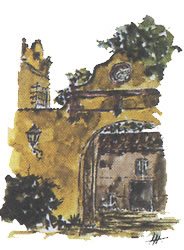Fibrochondrogenesis (Fibrochondrogenesis) - Genes and COL11A2 COL11A1
The fibrochondrogenesis is a serious disease of bone growth. Affected children have a narrow chest, preventing the lungs from developing normally. Because of this, most of those affected are stillborn or die shortly after birth from respiratory failure. However, some affected individuals have experienced in childhood.
The fibrochondrogenesis characterized by dwarfism and other skeletal abnormalities. Affected individuals have the long bones of the arms and unusually short and wide at the ends of legs (described as dumbbell). Other signs of the disease include a narrow chest with wide and short ribs prominent round abdomen, flat vertebrae (platyspondyly), an abnormal curvature of the spine and pelvis bones underdeveloped. People with fibrochondrogenesis also have distinctive facial features. These include prominent eyes, low - set ears, small mouth with a long upper lip, micrognathia, a small nose with a flat nasal bridge and anteverted nares. In addition, those individuals who survive childhood are common vision problems, including severe nearsightedness (high myopia) and cataracts. Most affected individuals also have sensorineural hearing loss due to abnormalities of the inner ear.
This may be due to mutations in the COL11A1 gene, located on the short arm of chromosome 1 (1p21) or COL11A2, located on the short arm of chromosome 6 (6p21.3). These genes encode components (chain pro-alpha 1 and alpha chain pro-2, respectively) of type XI collagen, a complex molecule that structure and strength to connective tissues that support joints and organs of the body. Specifically, the type XI collagen found in cartilage that makes up much of the skeleton in early development. Most cartilage is later converted into bone, except for the cartilage that covers and protects the ends of bones, or which is present in the nose and the outer ear. Collagen type XI is also part of the inner ear, the vitreous and nucleus pulposus.
They have identified at least seven mutations in the gene COL11A1 and two mutations in the gene COL11A2 in people with fibrochondrogenesis. Some cases are due to fibrochondrogenesis combination COL11A1 gene mutations. Specifically, a copy of the gene has a mutation which prevents synthesis of any functional chain pro-alpha 1 (XI), and the other copy has a mutation that results in an abnormal version chain pro-alpha 1 (XI). In at least two cases identified the fibrochondrogenesis is due to combinations COL11A1 gene mutations that inhibit chain coding pro-alpha 1 (XI). COL11A2 gene mutations associated with the development of fibrochondrogenesis result in the synthesis of an abnormal version chain pro-alpha2 (XI). When abnormal pro-alpha1 chain or pro-alpha 2 is incorporated in the collagen molecules, a type XI collagen is created defective. Defective collagen weakens connective tissues affecting bone formation along the skeleton and causing changes in the eye and inner ear leading to impaired vision and hearing.
The fibrochondrogenesis generally inherited in an autosomal recessive pattern, which means that both copies of the gene in every cell must have mutations for alteration is expressed. The parents of an individual with an autosomal recessive disease have a copy of the mutated gene, but usually show no signs and symptoms of the disease. In a few cases reported, parents of children with mild fibrochondrogenesis have shown characteristics that may be related to the disease, including short stature, myopia, cataracts, joint pain and hearing loss. In at least one case of fibrochondrogenesis due to a mutation of COL11A2 gene, the process is inherited in an autosomal dominant pattern, which means that a copy of the altered gene in each cell is sufficient to express the condition. This case was due to a new mutation in the gene that occurred during the formation of reproductive cells in one of the parents of the affected person. There was no history of the disease in the family.
Tests in IVAMI: in IVAMI perform detection of mutations associated with fibrochondrogenesis, by complete PCR amplification of the exons of COL11A1 and COL11A2 genes, respectively, and subsequent sequencing.
Samples recommended: EDTA blood collected for separation of blood leukocytes, or impregnated sample card with dried blood (IVAMI may mail the card to deposit the blood sample).



